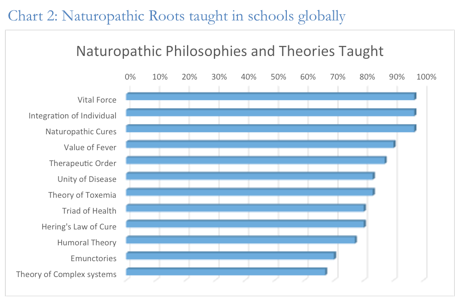Tina Hausser, ND
Iva Lloyd, ND, RPP
Naturopathic News
Naturopathy is considered a system of traditional medicine in Europe. In the late 1800s the practice of naturopathy spanned into North America, Western Pacific, and India. Today, naturopathy / naturopathic medicine is practiced in over 80 countries, spanning all world regions.
One of the initial tasks of the World Naturopathic Federation (WNF), when it was formed in 2014, was to determine how naturopathy is practiced throughout the world. The assumption was that the practice of naturopathy differed dramatically from one world region to another. To our surprise, the results of a global survey on naturopathy revealed that although the educational standards and the regulatory status of naturopathy are quite diverse, the underlying roots of naturopathy, how it is practiced, and the theories that guide assessment and treatment, are actually extremely similar.
A chart from the 1st survey (Table 1) illustrates the consistency worldwide among naturopathic principles. The results of that survey were published in June 2015 in the WNF document titled, “World Naturopathic Federation Report: Findings from the 1st World Naturopathic Federation Survey,”1 and can be accessed on the WNF website (www.worldnaturopathicfederation.org), under “Publications.”

After surveying the profession, the WNF sent out a survey in February of 2016 to 85 naturopathic institutions from 49 different countries. As set by the WNF, all naturopathic educational institutions had to offer a complete naturopathic program with a minimum of 1500 teaching hours. Thirty-six percent of the naturopathic educational institutions, spanning 5 world regions, responded. The results of this second survey echoed those of the first, that is, the roots of naturopathy are consistent globally.
As a result of the consistency in the 2 surveys, the WNF decided to create a White Paper outlining the philosophies, principles, and theories that define the global practice of naturopathy. What follows is a summary of that document.
Purpose of a White Paper
The purpose of a White Paper is to represent a unified voice on a particular topic. The aim of the WNF White Paper on naturopathic philosophies, principles, and theories is to provide clarification on the core concepts that compose the foundation of naturopathic practice.
The document will act as a guide for naturopathic educational institutions and will assist in providing a common framework for how these concepts are taught. Along with the document “Defining the Global Naturopathic Profession,”2 the White Paper will assist naturopathic organizations seeking regulation or recognition in clarifying the roots of naturopathy.
Creation of the White Paper
To compile the White Paper, the WNF Naturopathic Roots Committee requested the detailed curriculum notes on naturopathic philosophy, principles, and theories from 6 naturopathic educational institutions. The 6 selected universities/schools included training of both naturopaths and naturopathic doctors. Two of the selected schools offered a naturopathic program between 1500 and 2500 hours, 2 offered between 2501 and 3500 hours, and 2 offered over 3500 hours. The curricula differed in the length of time spent on each section; however, there was a high degree of consistency among the details taught with respect to naturopathic philosophies, principles, and theories.
Other references were used to support the curriculum details. The White Paper document includes a detailed list of the resources and references used.
The draft document was then circulated to all WNF members and sponsors for feedback. At the July 2017 WNF General Assembly, the “WNF White Paper: Naturopathic Philosophies, Principles and Theories”3 was endorsed by the WNF members.
The WNF White Paper is a 100-page document that includes an appendix of an historical overview and a book list. It provides a detailed review of each concept and includes some of the main contributors that have been instrumental in the development of the naturopathic concepts. The White Paper is a working document and will be modified over time to reflect the development of the naturopathic profession globally.
The Roots of Naturopathy – a Brief Synopsis
The foundational basis of the naturopathic profession includes 2 philosophies: vitalism and holism. It also includes 7 principles: First, Do No Harm (primum non nocere), Healing Power of Nature (vis medicatrix naturae), Treat the Cause (tolle causam), Treat The Whole Person (tolle totum), Doctor as Teacher (docere), Disease Prevention and Health Promotion, and Wellbeing. Finally, it includes 3 distinct theories: Humoral Theory, Emunctory Theory, and Therapeutic Order. Following is a snippet of the information contained in the White Paper. We encourage you to check out the White Paper document at http://worldnaturopathicfederation.org/wnf-publications/ for the full overview.
Philosophies: Vitalism & Holism
The philosophies of vitalism and holism are core to naturopathic practice globally. The combination of philosophy and medicine was common at the time when the relationship of health and diseases with nature became part of scientific thought under Thales of Miletus, around 600 BC. Health and diseases were no longer given mythological explanations; rather, reasons for the existence of natural phenomena were sought via theories and hypotheses, ergo science.
The roots of naturopathy go back thousands of years, relying on the healing wisdom of many cultures, including Indian (Ayurveda), Chinese (Taoist), Greek (Corpus Hippocraticum), Arabic, and European Egyptians (Monastic). In these early civilizations people lived in a harmonious relationship with their surroundings, and the understanding of disease was accomplished by observing nature and how it interplayed with human life.
What these traditional forms of medicine have in common is the understanding that the body has an innate ability to heal – referred to as vitalism – and that life, health, and disease follow certain laws and principles that are logical. They recognize that in order to achieve health, you must treat all aspects of an individual, also that health is dependent on a healthy lifestyle and on the health of the environment – referred to as holism. Vitalism and holism are the core naturopathic philosophies.
Vitalism is the basis for the development of the naturopathic principle Vis medicatrix naturae and the theories Vital Force and the Theory of Vitality.
Holism is considered the basis for development of the naturopathic principle Treat the whole person and for the naturopathic theories Integration of the Individual and Naturopathic Triad of Health.
Naturopathic Principles
Throughout time, practitioners and philosophers have created concepts to describe health and disease. The uniqueness of naturopathy arises from the application of 7 fundamental principles, which complement the naturopathic philosophies of vitalism and holism. Six of these principles were codified in 1986 by naturopathic doctors in North America, based on wisdom from the past and the review of current-day naturopathic concepts written by earlier naturopaths and philosophers. A seventh principle, “Wellness” is included in the teachings of a number of naturopathic schools around the world.
The naturopathic principles affect every aspect of assessment, diagnosis, and treatment. They are interdependent and they guide every aspect of the naturopathic encounter.
Naturopathic Principles
A summary of the 7 naturopathic principles are as follows:
- First, Do No Harm (primum non nocere) refers not only to the patient but to the patient’svital force. Naturopaths / naturopathic doctors work on the premise that there is a hierarchy to treatment choices. To do no harm, a naturopath / naturopathic doctor chooses the therapy, and fashions the most gentle and non-invasive strategy to achieve the desired outcome for each individual patient. To follow this naturopathic principle, every naturopath / naturopathic doctor needs to comprehensively self-educate about safety issues, including drug interactions with herbal and nutritional remedies.
- Healing Power of Nature (vis medicatrix naturae)denotes the body’s ability to heal itself. This healing power is an inherently self-organizing, ordered healing process of living systems, which establishes, maintains, and restores health. The vis medicatrix naturae has been referred to an extension of creator consciousness or cosmic consciousness. As the focus is on facilitating the endemic healing within a person, the role of the naturopath / naturopathic doctor is to support, facilitate and augment the vis medicatrix naturae.
- Treat the Cause(tolle causam) is a principle that stresses the importance of identifying and treating the cause(s) of disease. It is based on the realization that health and disease are logical; they happen for a reason. Identifying the root cause of disease and the aggravating factors is an essential aspect of naturopathic care. As part of the therapeutic encounter, a naturopath / naturopathic doctor explores a range of factors that impact health and disease, including genetics, lifestyle, social, environmental, external, and medical interventions.
- Treat The Whole Person(tolle totum) is a holistic concept that recognizes that the whole is greater than the sum of the parts. Each individual is unique with their own specific susceptibilities and way of manifesting disharmony and disease. It is the harmonious functioning of all aspects of individuals – within themselves, with others, and with their environment – which is essential to health. Disease affects the entire person, not just a specific organ or system.
- Doctor as Teacher(docere) comes from the Latin word “to teach.” The role of a naturopath / naturopathic doctor is to educate about the factors that affect health and disease so that individuals are more informed about the impact of their choices and so that they are more capable of maintaining their own health. Docere involves collaboration with the patient and other health professionals.
- Disease Prevention and Health Promotion involves promoting a healthy lifestyle, assessing risk factors, determining susceptibility to disease, and making appropriate therapeutic interventions. It involves assessing environmental and external factors that might be affecting health, determining the impact of social relationships and community on health (as well as genetic/hereditary factors), and assessing the impact of medical interventions to-date.
- Wellness or Wellbeing as a principle has been added by a number of naturopathic educational institutions, including Wellpark College in New Zealand and Bastyr University in the United States. “Wellbeing” is composed of the 2 words “well” and “being.” The concept of “wellbeing” indicates that it is not only “wellness” that is required for health, but also “being-ness” on a physical, psychological, and spiritual level.
Naturopathic Theories
Since the beginning of time, health practitioners have been searching for theories or laws that guide healing and that assist in understanding health and disease. What was discovered when we reviewed the curriculum from the schools is that schools in North America taught the philosophies of vitalism and holism, went into details on the naturopathic principles, and discussed the theories of Emunctories and Therapeutic Order. Naturopathic schools in Europe recognized the naturopathic principles as core to naturopathic practice, but went into details on many of the theories that preceded, and that are incorporated into, the naturopathic principles.
A chart from the 2nd survey (Table 2) illustrates the consistency among naturopathic theories taught in naturopathic schools. The results of that survey were published in July 2016 in the WNF document titled “WNF – Naturopathic Roots Report: Findings from the Naturopathic Roots Committee Survey”4 and can be accessed on the WNF website, under “Publications.”

One of the goals in delineating the naturopathic philosophies, principles, and theories is to avoid overlap and to clarify the proper placement of key concepts. For example, the theory Vital Force is synonymous with the naturopathic philosophy Vitalism; Integration of the Individual and Naturopathic Triad of Health are integrated in the naturopathic principle, Treat the Whole Person (tolle totum).
Some of the naturopathic theories are concepts used throughout the naturopathic encounter, such as Humoral Theory. Other naturopathic theories, such as Unity of Disease and Theory of Toxemia, are concepts that have been incorporated into the naturopathic principle, Treat the Cause (tolle causam). The remaining naturopathic theories – Naturopathic Cures, Value of a Fever, Therapeutic Order, Hering’s Law of Cure, and Emunctory Theory – are used to guide naturopathic treatment regimens.
Three core naturopathic theories – Humoral Theory, Emunctory Theory, and Therapeutic Order – are considered core to the practice of naturopathy globally and are expanded upon in the White Paper:
- Humoral Theory was an integral part of the origin of naturopathy. It explains the transmission of the elemental theory on the human body. Humoral Theory is a concept that spans all aspects of the naturopathic therapeutic encounter, including assessment, diagnosis, and treatment.
- Emunctory Theory states that proper elimination of toxins is essential to overall health. Eliminating toxins is often the first required treatment focus, especially for chronic disease. Elimination of toxins assists vitality and its corollary; conversely, lack of elimination blocks vitality or vital force. The primary emunctory pathways include the lungs (breath), kidneys (urine), bowels (stool), skin (sweating), menses/ejaculation, and voice (speaking). Secondary emunctory pathways include all other ways in which the body excretes toxins, including nasal discharge, eye discharge, and skin eruptions.
- Therapeutic Order was proposed as a naturopathic theory by Jared L. Zeff in 1997. Together with Pamela Snider, they collaborated in 1998 with the AANMC colleges to develop this theory. In the article from Zeff, Snider, and Stephen P. Myers, the Therapeutic Order is described in detail as a hierarchy of healing. The Therapeutic Order is a natural hierarchy of therapeutic intervention, based on or dictated by observations of the nature of the healing process, from ancient times through the present. It follows a natural ordering of the modalities of naturopathic medicine and their application.
The naturopathic Therapeutic Order is based on the concept that the body possesses an intrinsic nature to heal itself using the least possible force. The Therapeutic Order is the natural order in which naturopathic therapies should be applied in order to provide the greatest benefit and the least potential for damage.
 The WNF White Paper on naturopathic philosophies, principles, and theories will be followed up with other White Papers, such as one that describes naturopathic practice. To access the WNF White Paper, visit the WNF website at: http://worldnaturopathicfederation.org/wnf-publications/
The WNF White Paper on naturopathic philosophies, principles, and theories will be followed up with other White Papers, such as one that describes naturopathic practice. To access the WNF White Paper, visit the WNF website at: http://worldnaturopathicfederation.org/wnf-publications/
Refs:
- World Naturopathic Federation Report. Findings from the 1st World Naturopathic Federation survey. June 2015. WNF Web site. http://worldnaturopathicfederation.org/wp-content/uploads/2015/12/World-Federation-Report_June2015.pdf. Accessed August 15, 2017.
- World Naturopathic Federation. Defining the Global Naturopathic Profession. July 2017. WNF Web site. http://worldnaturopathicfederation.org/wp-content/uploads/2016/03/Defining-the-Global-Naturopathic-Profession_WNF-2017_.pdf. Accessed August 20, 2017.
- WNF White Paper: Naturopathic Philosophies, Principles and Theories. July 2017. WNF Web site. http://worldnaturopathicfederation.org/wp-content/uploads/2015/12/WNF_White_Paper_June-2017.pdf. Accessed August 20, 2017.
- WNF – Naturopathic Roots Report. Findings from the Naturopathic Roots Committee Survey. June 2016. WNF Web site. http://worldnaturopathicfederation.org/wp-content/uploads/2015/12/Naturopathic-Roots_final.pdf. Accessed August 15, 2017.





